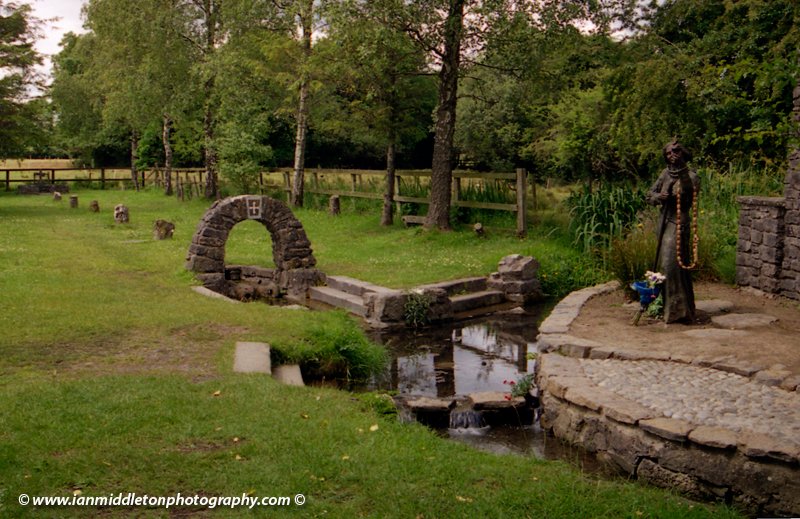St Brigid's Day
When many people think of Ireland and Saints, you can guarantee that in most cases the name Saint Patrick will come to mind. But there are many more noteworthy Irish saints, and among them is Saint Brigid. St Brigid’s Day day is Feb 1st.
Saint Brigid’s Cathedral in Kildare Town
The little county town of Kildare (Cill Dara) isn’t much to look at, and would likely not be as famous as it is today if not for the monastery established in the 5th century by Saint Brigid herself. Today a restored Norman cathedral stands on the original site and is dedicated to Saint Brigid.
At 33 metres the 10th century round tower in its grounds is the country’s second highest. When I visited back in 2004, I was surprised to learn that you can go inside and climb to the top. So I did. After a steep climb up wooden staircases I emerged at the top to a panoramic view of the surrounding landscape. Much of this part of Ireland is simply flat and green. Down below I could see clearly the square fire pit that was once the home to Brigid’s fire.
Back down below, the attendant told me that this is one of only two round towers in Ireland where you can go up inside. The other is at St Canice’s cathedral in Kilkenny. He walked me around the cathedral, showing me the other sites. At the front corner of the cathedral near the gates is a hole in the corner stone called the Wishing Stone. He explained that you must put your arm through the hole and place it on your other shoulder then make a wish. I declined for fear of not being able to retrieve my rather portly appendage.
Saint Brigid
Born into slavery in 453AD, Brigid was freed by the King of Leinster because she had grown into a beautiful young woman. The King planned to marry her to a great poet, but Brigid wanted to dedicate her life to God. One story goes that she marred her own beauty by contracting a skin disease in order to avoid this forced marriage.
Saint Brigid travelled on to the Hill of Uisneach, where the first fires were ceremoniously lit, to take her vows. Ever since, she associated fire with the new light of Christianity. She soon arrived in Kildare and built her monastery. She decided on Druim Criaig (Oak Covered Ridge) for the place on which to build her abbey. The town takes its name from this: Cill Dara (Church of the Oak).
On the hill of Kildare the pagan priestesses had been lighting fires to invoke the Goddess Brigid. It marks the beginning of spring was meant to protect the herds and make the harvest fruitful. This was a festival known as Imbolc (Imbolg). It is a Cross Quarter Day, midpoint between the Winter Solstice and the Spring Equinox, and falls between the 2nd & 7th of February.
Brigid continued the tradition along with 19 of her nuns by lighting a fire and keeping it alive, each nun tending the fire with Brigid tending it herself of the 20th day.
The perpetual flame, as it became known, was kept alive after her death by vestal virgins in the monastery in Kildare, and protected by the nuns until the twelfth century. The fire was re-lit in 1993 and has been kept alive by the Brigidine Sisters, in their home called “Solas Bhride (the light of Brigid)” ever since.
In 2005 a sculpture was commissioned by Kildare County Council to house the flame in Kildare Town Square. It was lit in an opening ceremony by the then President of Ireland, Mary McAleese on St Brigid’s Day in 2006.
The Goddess Brigid
Stories of Ireland’s Patroness seem to blend with those of the ancient Celtic goddess Brigid Bhoidheach (Bride the Beautiful). Brigid was the goddess of fire, arts and crafts, fertility and poetry. The legend of the goddess Brigid says she was the daughter of the Dagda. The Dagda mór mac Eladan, to use his full title, is the chief of the Celtic gods. The Dagda is the greatest of all the gods. A powerful wizard, his special sense was the power of knowledge; knowledge of what was to come or what was hidden. Some accounts also say that Brigid married King Bris, of the Formorians, an evil sea faring race from the North.
The Goddess Brigid was also worshiped on February 1st during the Pagan festival of Imbolg (or Imbolc). Brigid was also considered to be the guardian of newborn infants, and mothers regularly hung rowan crosses over their cradles and recited prayers to the Goddess to protect their children.
St Brigid’s Well and Cross.
Out on the Tully road, you can follow the signs for St Brigid’s Well. The well is situated in a grassy clearing, fenced off from the rest of the surrounding fields. A small stream called the Bratog flows into this clearing and to the well at the end. Beside the stream is a concrete crescent shrine to Brigid, with large crosses on wooden-beaded necklaces hung from various parts of the statue.
The Saint Brigid Cross is a unique Christian cross and symbolic of how the early Christian missionaries would blend pagan and Christian traditions as a way of easing the conversion of the locals to Christianity. It comprises a woven square in the centre and four radials tied at each end, and is made of rushes. The cross was, and probably still is traditionally hung on the kitchen wall to protect the house from fire and evil. According to legend, Saint Brigid weaved this cross at the death bed of a local chieftain, who subsequently asked to be baptised and converted to Christianity.
A stone archway marks the start of the five stones that lead up to the well at the end of the field. These stones mark the Turas, or pilgrimage, that is followed every year on St Brigid’s day, 1st February. This is a nice, well looked after site and a great place to relax for a while.
Accommodation in County Kildare
Getting to Ireland
Dublin is the main airport for the Rep of Ireland, or else Belfast in Northern Ireland. If you are coming from within Europe then the following airlines are worth looking at.
Wizz Air: Personally I have always found them to be the best and offer the lowest fares.
Skyscanner: A great place to search and compare flights
Ebookers: Ebookers have been around for longer than most and have always offered a great choice of flights.
Getting around
CAR
The best way to get around Ireland is by car. Either take your own car or you can rent one easily from Dublin or any other major city. Here are three great places to look:
BUS
The national bus service connects most major cities, towns and villages and is a good way to get around, especially if you want to meet some locals
If you want a fun way to travel with other like-minded travellers then try the Paddywagon
TRAIN
The national train service also serves a lot of the larger towns and cities. Great for getting from one side of the country to the other.
Tours:
Roc Tours Ireland – Great private driver tours all over Ireland. (Highly Recommended)
Accommodation
Holidu: This is a great website to search for a variety of places to stay.
Hostelworld: If you are looking for budget accommodation then Hostelworld is a great place to search for a variety of backpacker hostels, B&Bs and hotels.
My Ireland Book
Read the story of my first ever trip around Ireland in my book, Hot Footing Around the Emerald Isle.
With just a backpack as a home, a guidebook in one hand, a bizarre travelogue in the other and very little money in my bank account, I leave my home and set off to this little country that has always been my neighbour, yet overlooked by myself for many years as I pursued dreams to travel to far and exotic countries. However, I was soon to learn that one of the most beautiful places in the world was right on my doorstep.

















One Response